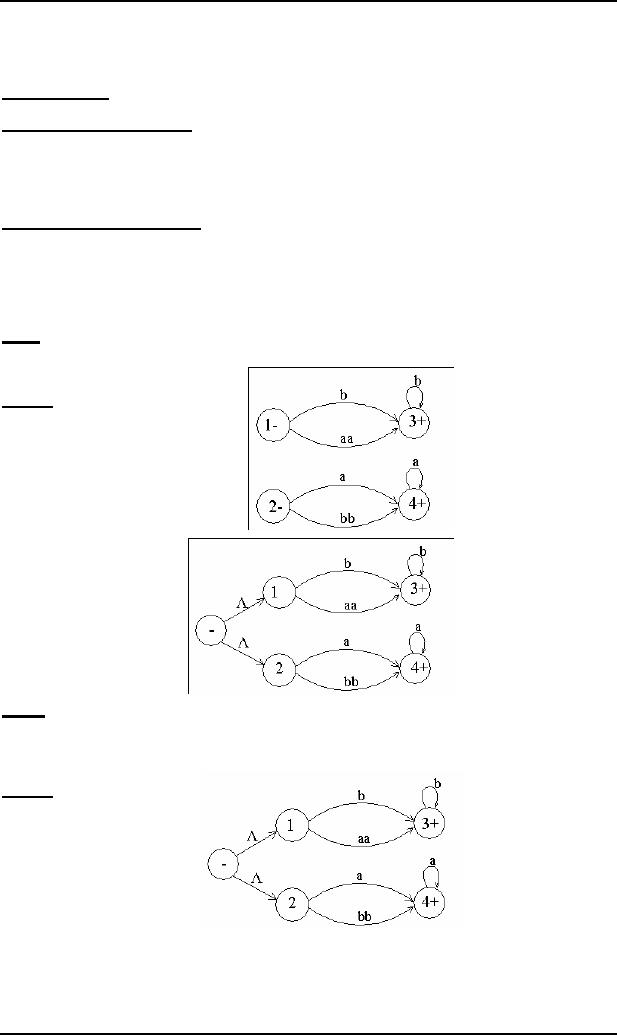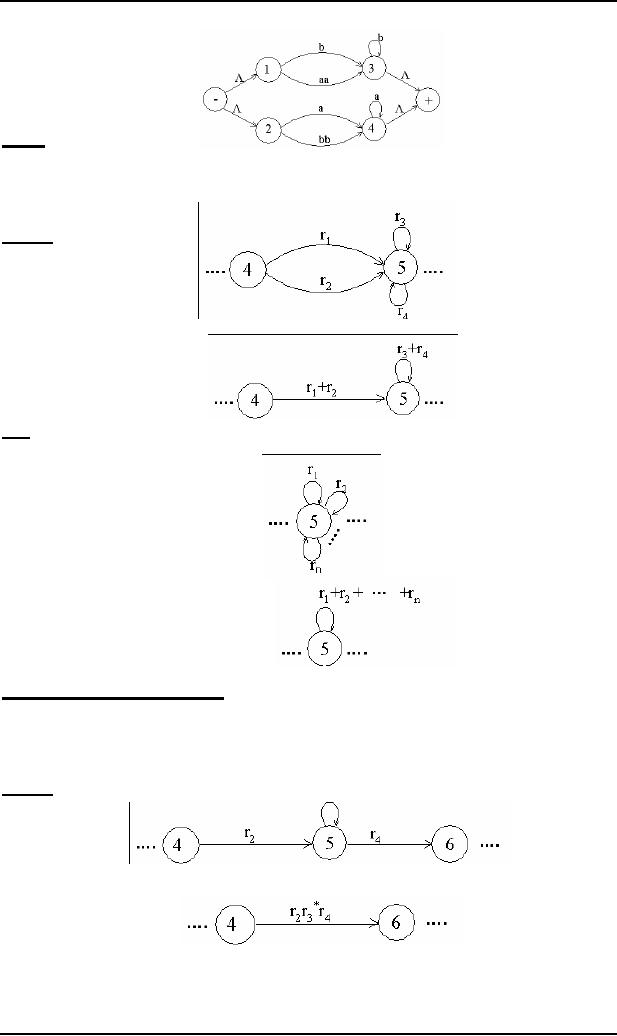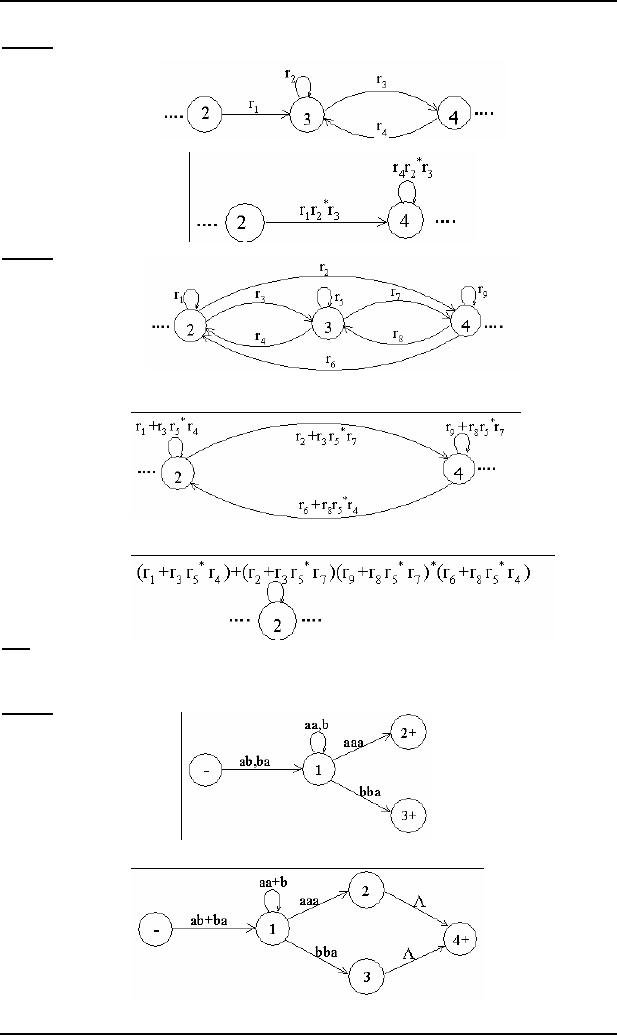 |
Proof(Kleene’s Theorem Part II) |
| << Nondeterminism, Kleene’s Theorem |
| Kleene’s Theorem Part III >> |

Theory of
Automata
(CS402)
Theory of
Automata
Lecture
N0. 11
Reading
Material
Chapter
7
Introduction
to Computer Theory
Summary
proof of
Kleene's theorem part II (method with
different steps), particular
examples of TGs to determine
corresponding
REs.
Proof(Kleene's
Theorem Part II)
To prove
part II of the theorem, an algorithm
consisting of different steps, is
explained showing how a RE
can
be obtained
corresponding to the given TG.
For this purpose the
notion of TG is changed to that of
GTG i.e.
the
labels of
transitions are corresponding
REs.
Basically
this algorithm converts the
given TG to GTG with one
initial state along with a
single loop, or one
initial
state connected with one
final state by a single transition edge.
The label of the loop or
the transition edge
will be
the required RE.
Step 1 If a TG
has more than one start
states, then introduce a new
start state connecting the
new state to the
old
start
states by the transitions labeled by Λ
and make the old
start states the non-start
states. This step can
be
shown by
the following example
Example
The
above TG can be converted
to
Step
2:
If a TG
has more than one final
states, then introduce a new
final state, connecting the
old final states to the
new
final
state by the transitions labeled by
Λ.
This
step can be shown by the
previous example of TG,
where the step 1 has already
been processed
Example
30

Theory of
Automata
(CS402)
The
above TG can be converted
to
Step
3:
If a
state has two (more
than one) incoming transition edges
labeled by the corresponding REs, from
the same
state
(including the possibility of
loops at a state), then
replace all these transition
edges with a single transition
edge
labeled by the sum of corresponding
REs.
This
step can be shown by a part of TG in the
following example
Example
The
above TG can be reduced
to
Note
The
step 3 can be generalized to
any finite number of transitions as shown
below
The
above TG can be reduced
to
Step 4 (bypass
and state
elimination)
If three
states in a TG, are
connected in sequence then eliminate
the middle state and
connect the first state
with
the
third by a single transition (include the
possibility of circuit as well) labeled
by the RE which is
the
concatenation
of corresponding two REs in the existing
sequence. This step can be
shown by a part of TG in the
following
example
Example
r3
To
eliminate state 5 the above
can be reduced to
Consider
the following example containing a
circuit
31

Theory of
Automata
(CS402)
Example
Consider
the part of a TG, containing a circuit at
a state, as shown below
To
eliminate state 3 the above
TG can be reduced to
Example
Consider a part of
the following TG
To
eliminate state 3 the above
TG can be reduced to
To
eliminate state 4 the above
TG can be reduced to
Note
It is to be
noted that to determine the RE
corresponding to a certain TG, four steps
have been discussed.
This
process
can be explained by the following
particular examples of
TGs
Example
Consider
the following TG
To have
single final state, the
above TG can be reduced to
the following
32

Theory of
Automata
(CS402)
To
eliminate states 2 and 3,
the above TG can be reduced
to the following
To
eliminate state 1 the above
TG can be reduced to the
following
Hence
the required RE is (ab+ba)(aa+b)*(aaa+bba)
33
Table of Contents:
- What does automata mean, Introduction to languages
- Kleene Star Closure, Recursive definition of languages
- Regular Expression, Recursive definition of Regular Expression
- Equivalent Regular Expressions
- Finite Automaton
- Equivalent FAs
- FA corresponding to finite languages
- Examples of TGs: accepting all strings
- Generalized Transition Graphs
- Nondeterminism, Kleene’s Theorem
- Proof(Kleene’s Theorem Part II)
- Kleene’s Theorem Part III
- Concatenation of FAs
- Closure of an FA
- Nondeterministic Finite Automaton, Converting an FA to an equivalent NFA
- NFA with Null String
- NFA and Kleene’s Theorem
- NFA corresponding to Concatenation of FAs
- Distinguishable strings and Indistinguishable strings
- Finite Automaton with output, Moore machine
- Mealy machine
- Equivalent machines
- Mealy machines in terms of sequential circuit
- Regular languages, Complement of a language
- Nonregular languages
- Pumping Lemma
- Pumping Lemma version II
- Pseudo theorem
- Decidability
- finiteness of a language
- Context Free Grammar (CFG), CFG terminologies
- Trees
- Polish Notation (o-o-o)
- Total language tree, Regular Grammar
- Null Production
- Chomsky Normal Form (CNF)
- A new format for FAs
- Nondeterministic PDA
- PDA corresponding to CFG
- Conversion form of PDA
- Conversion Form, Joints of the machine
- Row language, Nonterminals
- Non-Context-Free language, Pumping lemma for CFLs
- Decidablity, Parsing Techniques
- Turing machine